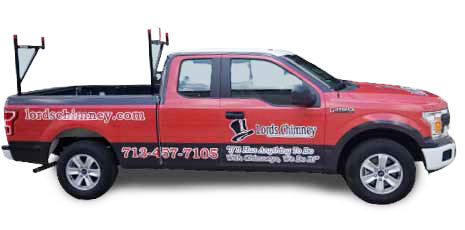Whether it’s a musty or moldy smell, a soft drip-drip sound coming from the chimney, or a puddle of water at the bottom of the firebox, a leaky chimney is a problem that cannot be ignored. Left unrepaired, even minor chimney leaks can create major damage throughout your fireplace system.
Thankfully, leaky chimneys don’t have to be a chronic problem. Identifying the source of the water entry and fixing your leaky chimney as soon as possible can prevent serious water damage to your fireplace system or home.
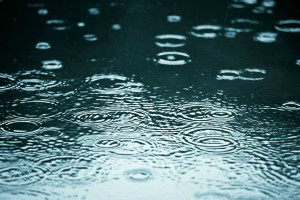
What causes chimney leaks?
Chimneys are built to stand strong against the elements; however, there are still a number of points where water can work its way into the chimney system. The following are some of the most common causes of chimney leaks.
Chimney cap: The chimney cap protects the top of the chimney and keeps moisture, animals, and debris from falling into the chimney. A damaged chimney cap can allow water into the flue, causing damage throughout the fireplace and chimney structure.
Chimney crown: Often confused with the chimney cap, the chimney crown is a mortar slab that seals the top of the chimney. Chimney crowns should have small overhangs as well as be built with slightly sloped edges to prevent water from pooling on the top. Chimney crowns can deteriorate over time due to prolonged exposure to the elements; this creates cracks that allow moisture into the chimney.
Flashing: Flashing is the watertight metal strips that seals the joint between the chimney and the roof. Over time, flashing can lose its seal due to overexposure to the elements; flashing can also be damaged by storms or animals.
Masonry damage: Without regular maintenance, bricks and mortar can begin to deteriorate over time. The freeze thaw process – which causes water in bricks to freeze and expand – is the most common cause of water damage to masonry.
Fixing a leaky chimney
When it comes to fixing a leaky chimney, the most important step is to find and repair the cause of the chimney leak. Repairing the water damage without first removing the cause of the chimney leak will only lead to recurrent water problems. By uncovering the root cause of the chimney leak, you can rest assured that the water damage will not return once the necessary repairs have been made.
For chimneys with damaged masonry, tuckpointing may be used to repair or replace damaged bricks and mortar. During the tuckpointing process, small areas of damaged masonry are carefully removed before the new bricks and mortar are put in; this can help strengthen the chimney structure and help avoid the costs of rebuilding the entire chimney.
Another great way to prevent chimney leaks and water damage is by having your chimney waterproofed. Professionally waterproofing a chimney can seal and protect the masonry from water damage while still allowing the bricks to retain their semi-porous nature.
If you have a leaky chimney, trust the experts at Lords Chimney to repair it. Contact us today to schedule an appointment so we can help resolve your chimney leaks!
When stains appear on the sides of a chimney, many homeowners falsely assume it is a natural part of an aging chimney. Unfortunately, chimney discoloration is often more than just a simple eyesore. Chimney stains and discoloration may indicate the presence of damage or other problems. The following are five of the most common kinds – and causes – of chimney discoloration.
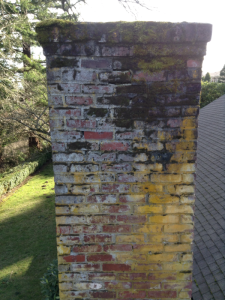
Black stains
Black stains on interior masonry are caused by soot buildup. Soot staining is often the sign of a chimney that has not been properly cleaned or maintained. Likewise, soot stains can also be caused by burning the wrong materials, such as green wood or paper and cardboard.
While soot stains are relatively common on older masonry chimneys, gas fireplaces should never have soot stains. Soot stains, especially those around the top of the chimney, indicate that there is a problem with the gas fireplace and the fuel is not burning correctly; soot staining on gas fireplaces can sometimes indicate a carbon monoxide leak.
Brown/black stains
Brown and black staining around the chimney cap or down the sides of the chimney structure is one of the most common kinds of chimney stains. While most homeowners assume this kind of discoloration is simply staining from soot, it is typically caused by excessive creosote buildup in the flue. If a chimney is not regularly swept, creosote can build up to the point where runoff stains the top and sides of the chimney. Because creosote staining is so similar to soot staining, a chimney sweep may be needed to evaluate the difference between the two.
Green stains
Green or dark green discoloration on a chimney is caused by the growth of mold and algae. This kind of green staining is most commonly seen in areas where water directly flows. Chimneys without a lip on the chimney crown may be particularly susceptible to algae or mold growth as the water travels over the masonry.
Red/brown stains
Red and brown rust stains are almost exclusively seen with prefabricated or metal chimneys. Because factory build chimneys have metal chase covers, they are prone to rusting. When this occurs, dark brown, red, and orange rust stains will begin to streak down the sides of the chimney chase. If rust staining is noticed, the chimney should be inspected immediately for signs of water damage caused by a chimney leak.
White stains
White stains on masonry structures are known as efflorescence. As water in the brick evaporates, it leaves behind mineral salt which then creates powdery white or crystalline discolorations on the masonry of the chimney. Exterior efflorescence is usually harmless and caused by ground or rain water. However, interior efflorescence may indicate the presence of a chimney leak.
Chimney stains do more than just affect your home’s curb appeal; they can also indicate the presence of a serious chimney problem. Schedule an appointment with Lords Chimney today to find out if your chimney discoloration is cosmetic or caused by something more serious.
When it comes to fireplace and chimney service, installation, and maintenance, finding the right company to work with can be hard to do. With so many businesses to choose from, it can be difficult to determine the seasoned professionals from the seasonal workers.
Although anyone with a brush and a truck might be able to call themselves a chimney sweep, few have earned the Chimney Safety Institute of America, or CSIA, certification. By hiring a certified chimney sweep, you can feel confident that you are working with a highly trained and educated professional.
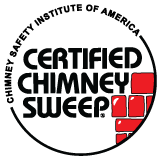
Are all chimney sweeps certified?
Many homeowners mistakenly believe that all chimney sweeps are created equally. Unfortunately, there are few regulations or restrictions on the industry. Because of this, any handyman with a couple of brushes can call themselves a chimney sweep. Oftentimes, these “chimney sweeps” do little more than push around the ash and soot in your chimney, making more of a mess than actually cleaning the chimney.
In order to get the best service possible for your fireplace and chimney system, it is important to work with a CSIA certified chimney sweep. The CSIA certification is recognized as the gold standard in the industry. Chimney sweeps that hold a CSIA certification have completed extensive education, training, and testing and represent the best in the industry in terms of skill and professionalism.
In order to earn their CSIA certification, chimney sweeps must study and be tested on topics such as:
- Fireplace and chimney safety practices
- Local and national building and fire codes
- Fireplace and chimney building dynamics for wide range of units
- Installation and maintenance practices for fireplaces, inserts, and stoves
- Current EPA standards for fireplaces, inserts, and stoves
CSIA certified chimney sweeps must also stay up to date on current industry practices. Because they must retest every three years in order to maintain their certification, CSIA-certified sweeps have information on the most recent safety and technology developments and best practices in the industry.
Hiring a certified chimney sweep
Because chimney maintenance can directly impact the safety of you and your family, it is important to work with a professional that you trust. Before hiring a chimney sweep, consider asking them the following questions:
- How long has your chimney sweeping company been in business?
- Can you offer current references?
- Do you have unresolved complaints filed with any consumer protection agencies or the Better Business Bureau?
- Does the company or the individual chimney sweep carry business liability insurance policy to protect my home and furnishings against accidents?
- Will the company guarantee that a CSIA Certified Chimney Sweep will be on my job site?
Don’t trust your family’s safety to the cheapest company you can find. Instead, hire a CSIA certified chimney sweep to ensure that your chimney’s maintenance and repairs are done correctly – the first time. In the Houston area, contact Lords Chimney to schedule an appointment with our CSIA certified chimney sweeps!
When it comes to chimney maintenance, most homeowners remember to clean out their fireboxes and know they need to have their chimneys swept. However, many may forget that some of the most important parts of the chimney cannot be seen from street level. One of these chimney parts that is often ignored is the chimney crown.
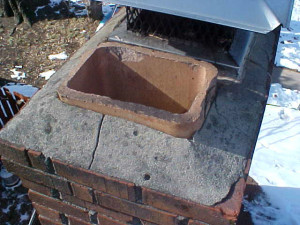
What is the chimney crown?
Chimney crowns are the slightly-angled slabs that surround and protect the top of the flue. Sometimes referred to as a chimney wash, the chimney crown acts as the base for the chimney cap; chimney crowns are designed to help moisture from ice, rain, or snow to flow away from the chimney structure and safely onto the roof.
What causes chimney crown damage?
There are a number of factors that can cause chimney crown damage. One of the primary causes of chimney crown damage is improper construction. Oftentimes, inexperienced contractors build the chimney crown using mortar instead of cement. Mortar, however, deteriorates much faster than concrete, especially when constantly exposed to the elements. The can cause the chimney crown to crack and spall, allowing moisture into the chimney structure.
Another major cause of chimney crown damage is long-term exposure to the elements without upkeep. Because of their location, chimney crowns take the brunt of Mother Nature’s forces; they are constantly exposed to varying temperatures as well as large amounts of moisture. These conditions can take a toll on chimney crowns, especially if it is not correctly angled. If left too flat, water and moisture can accumulate on the chimney crown and cause further damage.
Chimney crowns may also lose their watertight seal around the flue. This happens due to long term extreme temperature variations caused by fireplace use. The hot air and gas from a fire as it travels up the flue along with the cold outside air temperatures can cause the chimney crown to expand and contract, breaking the seal. This can let water into the chimney, causing even faster deterioration.
Chimney crown repairs
If your chimney is leaking, your chimney crown may be to blame. In these cases, we often recommended either repairing or rebuilding the chimney crown. The amount of repair needed will depend on the amount of damage the chimney crown has suffered.
When building or repairing a chimney crown, one of the keys is to make sure the edges extend over the sides of the chimney structure. This lip is known as a kerf and should extend at least 2-2.5 inches beyond the sides of the chimney. This acts as a rain gutter that helps water flow away from the chimney and onto the roof.
If your chimney crown only needs minor repairs, we often recommend CrownCoat, a professional waterproofing sealant that can help protect and extend the life of your chimney crown. When applied professionally, CrownCoat comes with a 15 year warranty, giving you peace of mind that this eco-friendly product will last.
Whether your chimney crown has minor damage or needs to be complete rebuilt, trust the experts at Lords Chimney to repair your chimney crown.
Spring and summer rain showers and thunderstorms are often a welcome reprieve from the scorching temperatures. In addition to cooling us off, these rain storms also keep our lawns and gardens green and our rivers and lakes full and ready for summer fun.
Unfortunately, heavy rain can also lead to a leaky chimney. Chimney leaks are one of the most common chimney problems we see during the summertime. Even chimneys without previous problems can develop leaks – and their accompanying water damage – in as little as one season.
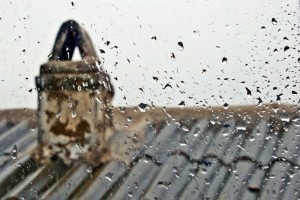
What causes chimney leaks?
Although chimneys look like simple brick or stone columns, they are actually complex structures with a number of different pieces and parts. Because the chimney is constantly exposed to the elements, its masonry is at greater risk for damage and breakdown.
The following are some of the most common causes of chimney leaks.
Chimney cap: The chimney cap protects the top of your flue from water entry, as well as animals and debris. Without a properly fitted chimney cap, the flue and fireplace are left completely exposed to water entry from rain.
Flashing: Flashing is the water tight strips that seal the seam between your roof and the chimney structure. If flashing is incorrectly installed, damaged, or merely loses its seal due to wear and tear or age, water can easily seep through any gaps. This can cause water damage to not only the roof and chimney, but also the ceilings and walls around the chimney.
Masonry damage: If one side or part of your chimney is often directly exposed to rainfall or other sources of water, the masonry may deteriorate or become damaged faster than the rest of the chimney. Water can cause bricks to crack and spall; in addition to making your chimney look aged or unkempt, it can also affect the structural stability of the chimney and lead to chimney leaks.
Symptoms of a leaky chimney
Many homeowners falsely assume that all leaky chimneys present themselves as visible water in the fireplace or flue. However, because of the size and complexity of most chimney systems, chimney leaks are often not recognized until they’ve already caused significant damage.
Below are some of the signs that may indicate your chimney is leaking.
- Water or condensation inside the firebox
- Sound of dripping water in the chimney
- Moisture, leaks, or water staining on walls or ceilings around chimney
- Musty or dank odors, especially after it rains
- Cracked or spalled interior or exterior masonry
Preventing chimney leaks
The best way to prevent chimney leaks is by having regular preventative maintenance done on your fireplace and chimney. Annual chimney sweepings and inspections can often identify any new chimney or masonry damage, allowing you to have it repaired before it leads to a chimney leak.
Another option for preventing leaks and water damage to your chimney is to have your masonry waterproofed. The waterproofing process involves the application of a specially designed sealant that keeps water out while allowing the masonry to retain its semi porous nature. These products can even be applied to chimneys with existing water damage as a way to keep it from getting worse.
If a summer rainstorm has left you with a leaky chimney, contact Lord’s Chimney today. Our expert staff can identify and resolve the source of your leaky chimney!

